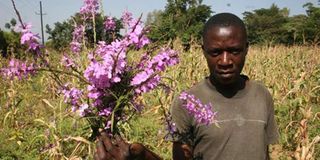Farmers find way to control weeds

Mr Eric Omondi Migele uproots Striga weeds in Kombewa, Kisumu County. Farmers are now using the climate smart push-pull method to defeat the destructive weed and pests like the stem borer. FILE PHOTO |
What you need to know:
- Simple inter-cropping method will kill off the destructive Striga weed and stem borers.
A scientific study has shown that an inter-cropping method used by farmers to control Striga and stem borers has the capability of increasing cereal yields.
The study, released by the Nairobi-based International Centre of Insect Physiology and Ecology’s (ICIPE), shows how effective the system, dubbed the climate smart push-pull technology, is.
It involves inter-cropping cereals with a pest repelling plant, such as desmodium, which drives away stem borers.
The desmodium plant repels stem borers from the target food crop while Napier grass, planted around the border of this inter-crop, pulls and traps the pests.
As a result, the food crop is protected from the pests, hence the name climate smart push-pull technology.
The study, done between 2013 and 2014, showed that the method effectively controls stem borers and the Striga weed.
STABILISE SYSTEMS
Dr Charles Midega, a scientist and lead study author at Icipe, said the technology would enable farmers in dry areas to stabilise their cereal and livestock mixed production systems.
“The method will enable farmers to increase yields by 2.5 times, and in addition, integrate dairy farming into their production systems,” he said.
“We found that in the fields of farmers using the climate-smart push-pull, only about five per cent of the maize crop was destroyed by stem borers. In contrast, farmers not using the technology lost an approximate 40 per cent of their maize crop to stem borer damage,” said Dr Midega.
“Our study showed that the climate-smart push-pull effectively controlled Striga, the weed barely emerged in the fields where the technology was applied. This evidence was supported by the fact that in neighbouring fields not using the climate-smart push-pull, an average of 20 Striga plants emerged around each individual maize plant,” he said.
“Climate-smart push-pull farmers harvested an average of four tonnes of maize per hectare, while the other farmers obtained an average of 1.5 tonnes per hectare.”
He said the simple method makes cereal-livestock mixed production systems resilient and enables the production of cereals in previously unsuitable regions.
“Our goal is to make the technology accessible to millions of smallholder farmers living in the drier regions,” said Dr Midega.
“Since farming is dominated by mixed crop-livestock systems, and cultivable land is becoming less and less due to population increase, there is need for technologies such as the climate-adapted push–pull, which will allow intensified agriculture,” notes Prof Zeyaur Khan, the Icipe leader of the push-pull programme.
WOMEN-FRIENDLY
Prof Khan said the technology is women-friendly and alleviates a number of burdens faced by African women farmers.
“Women spend substantial amounts of time hand weeding and collecting animal feed, among other tasks, the climate-smart push pull can be effective for them,” he said.
He said currently over 110,000 farmers in Africa are applying a climate-smart version of push-pull.
The farmers currently applying the method live in the drier areas of western Kenya, eastern Uganda, the Lake Victoria basin, Tanzania, and northern Ethiopia.
The study was conducted in 400 selected farmers in Kenya, Uganda and Tanzania.
He added that about 60 per cent of the farmers who have adopted the push-pull method are women, who no longer have to undertake these gruelling tasks.
“Once the ‘push-pull’ plots are established, they require very little weeding. In addition, since push-pull prevents the germination of Striga, women no longer have to spend hours uprooting it,” said Prof Khan.
He said that the women do not have to travel long distances to collect poor quality animal feed because the push-pull intercrops — desmodium and Napier grass — provide high quality fodder.





